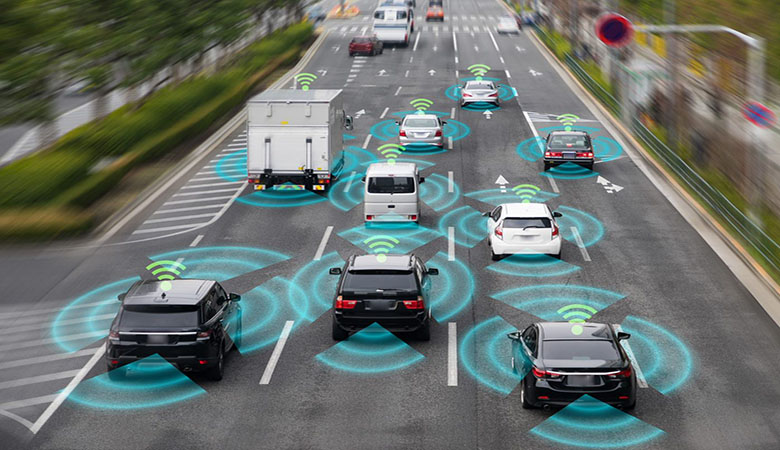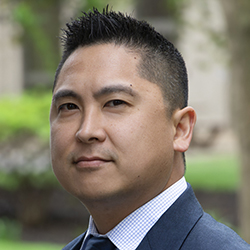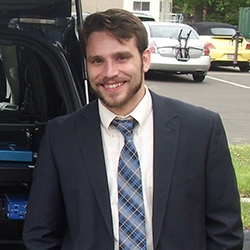Advanced Vehicle Technology

About Us
The U.S. DOT Volpe Center's Advanced Vehicle Technology Division focuses on the safety and cybersecurity of motor vehicle systems and supporting infrastructure:
- Crash Avoidance:
We conduct research in crash avoidance to identify effective intervention opportunities for autonomous and cooperative systems and estimate their potential safety benefits. Key related projects include:- Safety assessment and benefits of crash avoidance systems based on vehicle-to-vehicle (V2V) and infrastructure-to-vehicle (I2V) communications for:
- Light-duty vehicles (passenger cars)
- Medium- and heavy-duty trucks and buses
- Target crash problem and safety benefits of crash avoidance and mitigation systems for vulnerable road users based on:
- Vehicle-to-Pedestrian (V2P) communications
- Vehicle-to-Motorcycle (V2M) communications
- Independent evaluation of V2V and I2V safety applications deployed in the Connected Vehicle Pilot program
- Driver adaptation to forward collision warning and automatic emergency braking
- Safety assessment and benefits of crash avoidance systems based on vehicle-to-vehicle (V2V) and infrastructure-to-vehicle (I2V) communications for:
- Safety of Automotive Electronic Control Systems:
We conduct research in the functional safety and the safety of the intended functionality of automotive electronic control systems to expand the knowledge base and develop safety requirements for emerging safety hazards, countermeasures, and automated vehicle controls. Key related projects include:- Vehicle-level hazard analysis of a concept Level 4 automated driving system
- System safety analysis of teleoperation concepts for Level 4 automated driving systems
- Automated lane keeping systems with integrated lateral and longitudinal control (i.e., braking and steering)
- Automotive rechargeable energy storage (battery) control systems
- Alternative approaches to functional safety assurance
- Identification of system interactive complexity metrics for automotive-embedded software
- Automated Vehicles:
We conduct research in the test and evaluation, safety assurance, performance requirements, and safety benefits estimation of automated vehicles and connected-automated vehicle mobility applications. Key related projects include:- Automated lane and headway keeping systems
- Target crash populations of automated vehicle applications
- Test and evaluation of cooperative automated driving systems:
- Car and truck platooning
- Eco-approach and departure at signalized intersections
- Lane change and merge
- Speed harmonization
- Naturalistic study of truck following behavior for automated truck platooning
- Transit bus applications of light and commercial vehicle automation technology
- Cybersecurity of Vehicle Systems and Supporting Infrastructure:
We evaluate cybersecurity risks to automotive control systems and architectures, and we conduct research, development, evaluation, and testing of automotive cybersecurity products and tools including open source and proprietary tools for automotive cybersecurity research. Key related projects include:- Cybersecurity best practices for connected and automated vehicles
- Cybersecurity analysis of teleoperation concepts for highly automated vehicles
- Cyber physical systems security for automobiles
- Research and development planning for automotive cybersecurity
- Tools and testing for automotive cybersecurity
- Cybersecurity of heavy trucks
- Heavy truck industry profile and stakeholders
- Cybersecurity assessment and best practices for truck-stop technologies
- Telematics risk assessments
- Open-source cybersecurity tool web portal
Our experienced engineering team is made up of general engineers, electronics engineers, and mechanical engineers. Our sponsors include FHWA, FMCSA, NHTSA, ITS JPO, DHS, DOD, among others across government and industry. Potential societal benefits of our work include:
- Traffic safety
- Traffic mobility
- Economic productivity
- Accessibility
Our Capabilities
Safety and Cybersecurity Assessments
- Perform automotive hazard analysis, causal factor analysis, and risk assessments
- Research vehicle defect causes and unsafe control actions
- Develop cybersecurity requirements for government vehicle procurement
- Perform vulnerability testing and vehicle telematics systems assessments
- Evaluate intrusion detection and prevention systems
- Test and evaluate cooperative automated driving systems
Data Analysis
- Work with national crash data queries and pre-crash scenario typology
- Analyze and mine naturalistic driving data
- Develop use cases for simulation, testing, performance requirements, and safety impact assessments of highly automated vehicle functions
Impartial Investigations and Program Evaluations
- Perform motor vehicle crash analysis and state-of-the-art technology assessments
- Evaluate field operational tests
- Leverage open-source tools and hardware interfaces for vehicle research
- Perform objective testing of vehicle safety and crash test systems using test procedures and instrumentation, performance requirements, standards, and measures, and benefit estimation and simulation tools
Meet Our Team
View selected staff biographies.
 Mikio Yanagisawa
Mikio Yanagisawa
Chief
Mikio Yanagisawa holds a BS in Mechanical Engineering from Northeastern University (Boston, MA). Since joining the U.S. DOT Volpe Center in 2005, he has led projects to assess the safety impact of emerging vehicle-safety systems. These projects developed frameworks to collect and analyze real-world data and determine the safety benefits of passive and active safety systems for all vehicle body types and road users. Yanagisawa’s recent technical contributions have provided U.S. DOT modal agencies with detailed crash data queries and analyses, development and evaluation of test procedures for production and near-term systems, and simulation of vehicle conflicts.
He has made significant contributions to vehicle safety research, including the:
- Definition and identification of pre-crash scenario typology using national crash databases
- Target crash population definitions for emerging vehicle safety technologies using pre-crash scenarios
- Progression of defining crash statistics and safety impact assessment for specific vehicle body types (passenger vehicles, medium-duty and heavy-duty vehicles, motorcycles) and road users (pedestrians)
- Development and evaluation of test procedures for vehicle-based safety systems (pedestrian crash avoidance and mitigation (PCAM), intersection applications, automatic emergency braking (AEB), lane departure)
- Development of frameworks and assessment of potential safety benefits of PCAM, AEB, lane departure warnings, and intersection safety applications to support U.S. DOT priority goals
- Advancement of vehicle safety research in emerging technologies such as connected vehicles and automated vehicles for multiple agencies including NHTSA, FMCSA, and FHWA
 Andrew Berthaume, PhD
Andrew Berthaume, PhD
General Engineer
Andrew Berthaume has worked for the U.S. DOT Volpe Center for the past ten years. He is a project manager and technical expert in the Advanced Vehicle Technology Division. Berthaume leads a portfolio focusing on traffic safety and operations, automated and connected vehicles, traffic modeling and Intelligent Transportations Systems. He is a member of the Transportation Research Board’s (TRB) Committee on Traffic Simulation and has taught graduate engineering courses at the University of Massachusetts-Lowell. Berthaume has recently led work for Turner-Fairbank Highway Research Center to collect work zone behavioral data and develop a car-following model for freeway work zones. He also served as a principal investigator for FHWA’s Driver Model Software for Practical Application and Advancing Research Capabilities through Cooperative Driving Automation Data. Berthaume has published several papers for TRB, Transportation Research Record, and national engineering organizations. He holds a Bachelor of Science, master’s degree, and PhD in civil engineering from the University of Massachusetts at Amherst (Amherst, MA).
Daniel Chin
Computer Engineer
Daniel Chin received his BS in Computer Engineering from the University of Massachusetts Amherst (Amherst, MA) in 2016. He has been with the U.S. DOT Volpe Center for more than five years with experience in cybersecurity of automotive vehicle systems and in automotive vehicle functional safety applications. Some of his projects include cybersecurity assessments of telematics units and truck stop technologies, cybersecurity mitigation technologies for electronic control units in automotive vehicles, development of a simulation tool for advanced driving assistance systems, and the development of a wireless remote-controlled vehicle.
Anne-Marie Chouinard
General Engineer
Anne-Marie Chouinard holds a BS in biotechnology from Worcester Polytechnic Institute (Worcester, MA) and a MS in Learning, Teaching, and Educational Transformation from University of Massachusetts – Boston (Boston, MA). She has been with the U.S. DOT Volpe Center since 2016, working on:
- Modeling and Simulation Construction – created a network using SUMO simulation software to model tolling network, pre- and post-open gantry conversion.
- Database Analysis – constructed and investigated target crash populations and evaluated pre-crash scenarios to identify potential safety benefits. Leveraged data visualization using Tableau in conjunction with data mining techniques in R and Excel to refine algorithm to better capture conditions to shape various break-out groupings of desired conditions.
- Data Analysis – comparison of ACC and CACC runs to determine performance differences between the systems from data obtained from test vehicles.
- Modeling and Simulation Output Analysis – evaluated output from VISIM traffic simulation modeling software using Python and statistical tools to determine the effect of various levels of penetration of cooperative adaptive cruise control in traffic across different levels of congestion.
- Simulation Analysis – performed analysis on simulation data to determine reaction times and levels under different types of safety technology such as intersection movement assist, left turn assist, and forward collision warning.
 Brendan Harris
Brendan Harris
Cybersecurity Specialist
Brendan Harris is a cybersecurity specialist in the Advanced Vehicle Technology division at the U.S. DOT Volpe Center. He also serves as the technology manager for cybersecurity at the Joint Office of Energy and Technology. Harris has more than 14 years of experience leading and executing federal cybersecurity research and development projects. His area of expertise is joining the cybersecurity and systems engineering disciplines at the intersection of transportation, communications, and electrification technologies. Through his work, Harris researches and evaluates how emerging cybersecurity tools, techniques, vulnerabilities, and mitigations apply to modern vehicle architectures and critical infrastructure. These activities help develop and socialize cybersecurity best practices, emerging technology, and industry standards through stakeholder engagement, technology transfer, and community development. His projects have been sponsored by numerous federal offices including Department of Homeland Security’s Cyber and Infrastructure Security Agency, NHTSA, and Department of Energy’s Vehicle Technologies Office. Harris has also worked internationally to share his expertise with Transport Canada.
Faroog Ibrahim, PhD
General Engineer
Faroog Ibrahim, PhD has more than 25 years of wide spectrum of expertise in ADAS/Active Safety, Automated Vehicles, Connected Vehicle, Smart Cities, Cooperated Driving Automation and its simulation, Digital Map as an automotive sensor, Positioning, and Sensor Fusion. This experience includes leadership, business development, requirements developments, Algorithm developments, Control, Simulation, HMI, testing and validation, and standardization. He was in the OEM’s side, Tier1, and Tier2 side, and was heavily involved in the Model Deployment Safety Pilot, NY CV Pilot, and Tampa CV Pilot. Ibrahim holds more than 50 patents and 50 published papers. He also has more than ten years of teaching and research experience at universities and research institutes including lecturing at the University of Michigan.
Ibrahim has been a U.S. expert at ISO/TC204/WG14 since April 2008, standardizing many aspects of intelligent transportation system including L3 and L4 AD systems, and has successfully led the development of the CACC, FVCWS and VVICW ISO standards. He is currently supporting different projects in advanced ITS for various sponsors, including FHWA, FMCSA, Maritime, OSR- R/P, ITS JPO, and recently attending two kickoff meetings for NHTSA projects with UMTRI. Ibrahim has been also playing a technical advisory role for different U.S. DOT team members as needed.
Ahmad Nasser
Electronics Engineer
Ahmad Nasser holds a BSEE and MSEE from the University of Michigan (Ann Arbor, MI). He has more than 32 years of automotive experience including 14 years in the development and applications of driver assistance and driver safety technologies, including camera, radar, ultrasonic sensors, and sensor fusion based technologies. Nasser worked with most automotive safety standards and regulations with more than 13 years of experience in functional safety, serving:
- As a member of the U.S. committee that updated and released the second version of ISO 26262 and the Safety of the Intended Function ISO/PAS 21448
- On the SAE committee that developed and released SAE J2980.
As a member of the U.S. DOT Volpe Center team, Nasser worked in two major areas:
- Safety of automotive based systems where he conducted safety analysis and developed functional safety concepts for several vehicle systems including high energy storage, powertrain, steering, and braking, as well as Level 4 autonomous system, teleoperation system, and Cooperative Driving Automation (CDA) system.
- Transferability of driver assistance and safety technologies from passenger vehicle applications to Medium and Heavy Duty commercial vehicles, buses, and school bus applications.
His additional expertise includes the use of statistical tools, as a Certified 6-Sigma Master BB Level II, with high technical expertise in Vehicle Drive Systems.
Raymond Resendes
Principal Technical Advisor for Cybersecurity
Raymond Resendes serves as part of our team of principal technical advisors who work across the Center to identify emerging transportation technologies, conduct analyses and assessments on topics of national significance, and explore new opportunities in response to evolving national concerns.
Resendes serves as principal technical advisor for cybersecurity.
